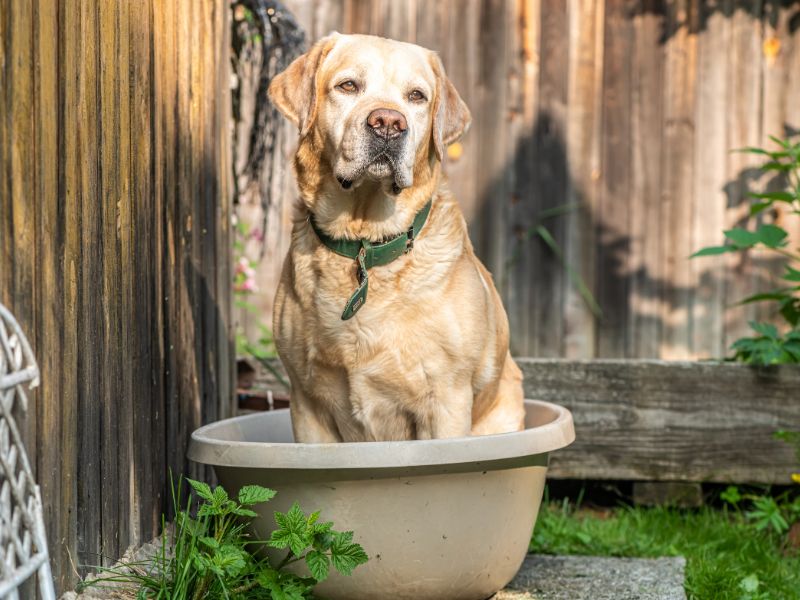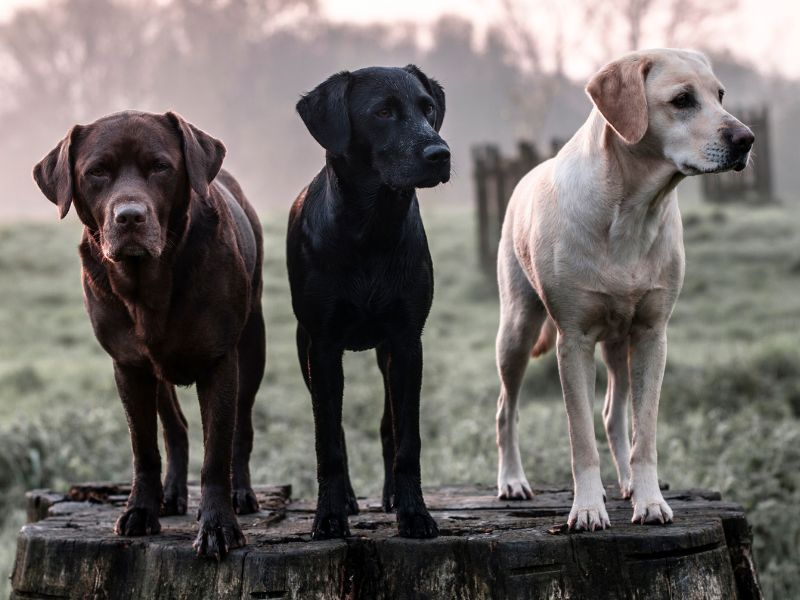Labrador Retrievers are one of the most popular dog breeds worldwide, known for their intelligence, trainability, and friendly nature. A common question among potential owners is which color Labrador is best. Three primary colors of Labradors exist, including black, yellow, and chocolate. It’s important to understand the various factors that may influence an individual’s preference for a specific color.
While some people may have personal preferences for a particular color, it’s essential to note that all Labrador Retrievers have similar qualities and temperaments. The primary difference between them is their appearance, but they all possess the same inherent characteristics and abilities. However, some generalizations have been made about different Labrador colors and their common associations.
Black Labradors, for example, have been linked with gun dog work while yellow Labradors are often associated with Guide Dogs for the Blind. On the other hand, chocolate Labradors have been connected to pet homes and the show ring. Ultimately, the choice of which color Labrador is best comes down to personal preference, as all Labradors excel in various roles and are equally lovable.
Do Labrador Dog Colors Matter?
Labrador Retrievers are recognized in three primary coat colors: black, yellow, and chocolate. These are the three colors that enthusiasts and potential owners are most familiar with. However, there are also rarer coat colors like silver, white, and red. Some people may wonder if a Labrador’s coat color affects its behavior, health, or pedigree status.
First and foremost, regardless of their coat color, Labradors are known to make excellent family pets, thanks to their friendly and loyal nature. Coat color has very little impact on a Labrador’s overall temperament and personality. These dogs are typically smart, gentle, and easy to train, which makes them excellent companions.
Although there is a debate surrounding which color is considered the best, it is mostly a matter of personal preference. While some people may be drawn to the classic black Labs, others may prefer the look of yellow, chocolate, or even one of the rarer colors.
In terms of health, there are no significant differences between the various coat colors. However, it is crucial to note that responsible breeding practices should be prioritized over selecting for specific fur colors. A well-bred Labrador from a reputable breeder is more likely to be healthy, regardless of its coat color.
Breed standards set by the American Kennel Club only recognize black, yellow, and chocolate Labradors. Thus, rarer colors such as silver, white, and red are not accepted for registration. Despite this, these uncommon coat colors do not affect the dog’s ability to perform tasks, whether it be as a hunting companion, a service animal or simply a family pet.
In conclusion, a Labrador’s coat color matters primarily in terms of personal preference, as it does not significantly impact their temperament, health, or the dog’s ability to fulfill specific roles. Therefore, potential Labrador owners should focus on finding a well-bred and healthy dog from a respected breeder, rather than getting caught up in the debate surrounding coat color.
Labrador Colour Inheritance
Labrador Retrievers are known for their three main coat colours: black, chocolate, and yellow. These colours are determined genetically, and their inheritance is a result of various distinct genes interacting with one another.
There is a fascinating range of shades within these three basic colours. For instance, yellow Labradors can range from a pale cream to a deep reddish-gold, known as fox red. Variation in the colours and shades is due to breeding practices or genetic differences, such as dilute genes that cause colours to appear more pale or muted.
The genetic basis of Labrador coat colour involves a series of genes that can be simplified into two primary components – the B gene, which controls the black and chocolate colours, and the E gene, which determines whether a yellow coat will be expressed.
A Labrador’s coat colour is inherited from its parents, with each puppy receiving one gene from each parent. For the B gene, B represents the black colour, and b represents chocolate. If a puppy inherits two black genes (BB), it will have a black coat, while a chocolate coat results from receiving two chocolate genes (bb).
However, if a Labrador inherits the recessive yellow gene (ee) from both parents, the E gene overrules the B gene, and the puppy will have a yellow coat, regardless of its B gene pair. To summarize:
- Two black genes (BB): Black Labrador
- Two chocolate genes (bb): Chocolate Labrador
- Two yellow genes (ee): Yellow Labrador (regardless of B gene pair)
In conclusion, Labrador colour inheritance is an intricate process involving multiple genes that determine a dog’s coat colour. By understanding these genetics, breeders can predict and select for specific coat colours when breeding Labradors.
Yellow Labradors
Yellow Labradors are perhaps one of the most recognizable and popular Labrador colors. These friendly and affectionate dogs have become synonymous with guide dogs for the blind and are often associated with companionship and families. They’re known for their intelligence, adaptability, and playful nature, making them excellent pets.
Yellow Labs come in various shades, ranging from a pale cream color to a darker golden hue. It’s not uncommon for yellow Labrador puppies from the same litter to be different shades. Additionally, a puppy may not always have the same shade of yellow as its parents. Typically, the coloration of a Yellow Lab is rarely uniform, with some parts of their body, such as ears, being darker or lighter than others.
The genetic makeup of Yellow Labradors is responsible for their distinct coats. The three main Labrador colors – black, chocolate, and yellow – are controlled by two genes: the B gene determines whether the coat will be black or brown, while the E gene controls the expression of the yellow coat color. Yellow Labs inherit their color from a recessive gene, meaning that both parents need to carry this gene for the offspring to be yellow.
Despite the well-known association with guide dogs, Yellow Labradors are versatile, and individuals of this color can excel in various roles. Like their black and chocolate counterparts, Yellow Labs make fantastic hunting companions and shine in various dog sports such as agility, obedience, and retrieving. They’re also commonly seen in the show ring, where their beautiful coats and charming personalities can win over judges and spectators alike.
In conclusion, the popularity of Yellow Labradors can be attributed to their striking coats, affectionate temperament, and versatility in fulfilling various roles. Whether someone is in search of a devoted family pet, an energetic hunting partner, or a reliable guide dog, the Yellow Labrador Retriever is a wonderful choice.
Fox Red Labradors
Fox Red Labradors, also known as Ruby Labradors, are a unique and striking variation of the yellow Labrador Retriever. Their captivating red-tinted coat sets them apart from the typical yellow Lab, making them quite the eye-catching breed. Fox Red Labs exhibit the same endearing qualities as any other Labrador, such as their lovable personalities, playful energy, and intellect.
The origin of the Fox Red Lab’s color lies in the genetics of the yellow Labrador. Breeders have begun selecting darker red Labrador Retrievers as they grow increasingly popular among dog enthusiasts. These stunning dogs showcase a range of red shades, from dilute tones to more vibrant rusty hues.
As with other Labradors, Fox Red Labs are intelligent and energetic creatures, making them excellent companions for active individuals and families. They thrive in environments where they can engage in physical activities and mental stimulation, benefiting from activities such as agility training, fetch, and obedience training.
In terms of health, Fox Red Labradors have similar health considerations as other Labradors. Common health concerns include hip and elbow dysplasia, exercise-induced collapse, and progressive retinal atrophy. It is essential for prospective Fox Red Lab owners to research and choose a reputable breeder to ensure their pup comes from healthy genetic lines.
When it comes to grooming, Fox Red Labradors have low-maintenance coats like other Labs. Regular brushing can help manage shedding and keep their vibrant coat looking its best. Additionally, it’s crucial to keep an eye on the cleanliness of their ears to prevent infections and maintain their overall health.
In summary, Fox Red Labradors are unique and visually striking dogs that possess the same cherished qualities as any other Labrador Retriever. These intelligent, energetic pups make fantastic companions for active families and individuals who appreciate their beauty and vibrant personalities.
Fawn Labradors
Fawn Labradors are a unique and beautiful shade within the yellow Labrador color spectrum. Their coat can vary from a light brown to a yellowish-brown hue, making them stand out among the more common black and chocolate Labradors.
These dogs possess the same friendly and sociable temperament that Labrador Retrievers are known for. As with all Labradors, Fawn Labs are intelligent and eager to please, making them great companions and family pets.
When it comes to their coat, Fawn Labradors require regular grooming to maintain their appearance and keep shedding under control. It is essential to brush their coat at least once a week to remove loose hair, prevent matting, and promote a healthy and shiny coat.
The coat color of Fawn Labradors does not have any significant impact on their health. Like other Labrador Retrievers, they may be prone to health issues like hip dysplasia, obesity, and ear infections. Therefore, it is vital to provide these dogs with proper exercise, a balanced diet, and regular veterinary check-ups.
Choosing a Fawn Labrador, or any other color of Labrador, ultimately comes down to personal preference. Regardless of their coat color, Labrador Retrievers make exceptional pets and are known for their loyalty and affection towards their owners.
Black Labradors
Black Labradors are a classic and popular choice among Labrador enthusiasts. They have a sleek and shiny black coat, making them an attractive option for both pet owners and those seeking a hunting companion. In fact, black Labs have long been favored as gundogs, but they also make wonderful pets, companions, and agility dogs.
Due to the way Labradors inherit color genes, black Labradors are the most common color variation. This explains why they might be a bit overlooked when it comes to people’s top picks of Labrador colors. However, their classic, striking appearance along with their loyal and loving nature make them a perennial favorite with good reason.
Beyond their physical appearance, black Labs often exhibit an excellent temperament, which makes them ideal family pets. They are known for their intelligence, trainability, and friendly nature toward both children and adults. With proper training and socialization, a black Labrador can be a fun-loving and gentle addition to the family.
While black Labradors are the most common color, it is essential to remember that the primary traits to focus on when selecting a Labrador are temperament, health, and overall quality of the breeder. A well-bred and well-trained black Labrador can be just as fantastic a pet as any other color.
In summary, black Labradors offer a classic, sleek appearance along with a wealth of desirable traits, making them an excellent choice for those seeking a loyal and loving companion. Their versatile nature and trainability make them suitable for a variety of roles, from hunting partners to family pets.
Get Pippa’s Training Tips!
When training a Labrador, it’s essential to have the right tools and information. Pippa Mattinson, a Labrador specialist and best-selling author, has dedicated over thirty years to breeding, training, and working with Labrador Retrievers. Her experience and knowledge can be invaluable for improving your Labrador training journey.
Pippa offers a wide range of dog training tips covering various topics, from specific techniques like heel work and recall to general advice on capturing your dog’s attention and setting both you and your dog up for success. These tips cater to Labradors of all colors, including the most common black Labrador as well as the unique red fox Labrador.
To access Pippa’s free dog training tips, you can visit her website Dogsnet. Here, she shares her expertise through a collection of dog training lessons, suitable for puppies and adult Labradors alike. It’s essential to have a tailored approach to each Labrador color, as some may exhibit different tendencies or behavior patterns due to their genetics.
Making use of Pippa’s training guides and tips will help owners create a stronger bond with their Labradors while ensuring they’re providing the most effective and enjoyable training experience for their furry friends. Incorporating Pippa’s advice can help both new and experienced Labrador owners navigate through their dog’s training journey with confidence and ease.
Chocolate Labradors
Chocolate Labradors, often known as “Chocolate Labs,” are a beautiful and unique variation of the popular Labrador Retriever breed. Their deep brown coats, sometimes called “liver” in the past, were once considered undesirable compared to their black and yellow counterparts. However, this perception has changed over time, and Chocolate Labs are now beloved by many dog enthusiasts.
The color of a Chocolate Lab’s coat can range from a light brown to a deep, rich chocolate hue. It’s important to note that even though their coats are brown, Chocolate Labradors are still purebred Labrador Retrievers. A true Chocolate Lab can only be bred from two purebred parents, but it’s worth noting that the parent Labradors do not have to be chocolate-colored themselves to produce a brown-coated offspring.
Unfortunately, Chocolate Labradors tend to have a slightly shorter lifespan than other Labrador colors. On average, Chocolate Labs live around 10.7 years, which is roughly 1.3 years less than the 12-year average lifespan of the breed. They are also more likely to experience health problems, so it’s crucial for owners to provide proper care and be vigilant in monitoring their dog’s health.
In terms of personality, Chocolate Labs share many traits with other Labrador Retrievers, making them fantastic companions for families, singles, or seniors. They are known for being friendly, outgoing, and adaptable, and excel in various activities such as agility, obedience training, and even search and rescue tasks.
If you decide to bring a Chocolate Labrador into your home, be prepared to invest time in training and be aware of their specific health needs. Their intelligent and loyal nature, coupled with their unique chocolate-colored coat, makes them an exceptional choice for a loving and devoted companion.
Silver Labradors
Silver Labradors, also called Blue Labradors, are a unique and beautiful variant of the popular Labrador Retriever breed. This distinct coloration is due to a recessive gene that can turn Chocolate Labs into Silver Labs, Black Labs into Charcoal Labs, and Yellow Labs into Champagne Labs. Although they are registered with the AKC as Chocolate Labs, Silver Labs are known for their stunning grey-blue coat, which is similar to the coat color of Weimaraners.
Silver Labradors typically grow to be the same size as other Labrador colors. Male Labs generally weigh between 70-85 lbs and stand around 24.5 inches at the shoulder, while females usually weigh 55-70 lbs and have a height of about 21.5 inches at the shoulder.
One unique aspect of Silver Labs is their eye color. Many of these dogs have blue-colored eyes, particularly during their younger years. However, it’s important to note that Silver and Charcoal Labs fall under the category of Chocolate and Black Labradors, respectively, and are not considered separate breeds.
Despite their unusual coloration, Silver Labradors are as friendly and intelligent as other Labs, making them fantastic companions and suitable for various activities and roles such as hunting, therapy work, and guide dogs. Just like their counterparts, Silver Labs require regular exercise and mental stimulation to stay happy and healthy.
When considering which Labrador color to choose, keep in mind that Silver Labradors, like other Labs, should be selected based on temperament and compatibility with your lifestyle rather than solely on their appearance. As with all Labradors, potential owners should be prepared to give their Silver Lab the love and care they need to thrive.
Which Is The Best Labrador Colour?
When discussing the best Labrador colour, it is important to consider that an individual’s preference can be entirely subjective. However, we can highlight some of the common characteristics associated with the three main Labrador colours: black, yellow, and chocolate.
Black Labradors are known for their association with gun dog work and historically retrieving game or fowl from water. They are considered intelligent, alert, and easy to train. Additionally, their beautiful solid black coat can be quite striking.
Yellow Labradors, on the other hand, are often known for their cheerful disposition and friendly nature. They make fantastic guide dogs for the blind and visually impaired due to their caring, attentive temperament. Yellow Labs can have various shades in their coat ranging from light cream to a darker golden hue.
Chocolate Labradors are praised for their loyal and loving nature, making them an ideal companion for families of all sizes. Their signature brown coat earns them a unique appearance that many find adorable.
In recent times, other Labrador colours, such as silver, charcoal, and red, have gained recognition. Nevertheless, the American Kennel Club still only recognizes the three main colours: black, yellow, and chocolate.
While each Labrador colour has its distinct traits, attributing qualities solely based on their coats is not always accurate. A dog’s temperament, intelligence, and affection can be largely influenced by factors such as genetics, upbringing, and training. Hence, choosing the best Labrador colour ultimately comes down to personal preference and compatibility with each individual dog.
Show vs Field Bred Labradors
When exploring Labrador colors, one must take into consideration that Labradors have become divided into two distinct types: show and field. These types significantly differ in appearance and temperament.
Show Labrador retrievers, also known as English Labs, are bred primarily for dog shows and companionship. They tend to have broader heads, thicker tails, and a barrel chest. English Labs are renowned for their friendly nature, making them ideal family pets. They are enthusiastic and love to greet everyone they meet, both human and canine.
On the other hand, field Labrador retrievers, also known as American Labs, are bred for hunting and other field activities. They are more slender and agile than their show counterparts. American Labs have a high prey drive, determination, and intense bond with their handlers. Their strong work ethic makes them excellent working or service dogs.
While the colors of Labradors do not necessarily impact their suitability for show or field purposes, historically, black Labs have been more commonly seen in dog shows and field championships. This is due to the black color gene being dominant in Labradors, leading to a higher prevalence of black Labs. However, the color of a Labrador should not be the sole determining factor when choosing a suitable dog; instead, focus on the type that best aligns with your preferences and lifestyle requirements.
To summarize the key differences between the two types of Labradors:
- Show Labradors (English Labs): Bred for dog shows and companionship, with a stockier build and friendly nature.
- Field Labradors (American Labs): Bred for hunting and field activities, with a slimmer build and strong work ethic.
In conclusion, when considering which Labrador color to choose, it is essential to also consider the type of Lab that best suits your needs and preferences. Understanding the differences between show and field Labradors will help in finding the perfect companion, regardless of your color preference.
Rescue Labradors
Rescue Labradors are dogs in need of a loving home and are often found in shelters or through dedicated rescue organizations. These dogs could be of any coat color, including the three main recognized Labrador colors, which are black, yellow, and chocolate.
Labrador rescue organizations are committed to finding the best possible homes for these dogs. They take the time to assess each dog’s needs and temperament, and carefully match them with an adoptive family capable of providing long-term support and love. Adopting a rescue Labrador can be highly rewarding, as one can witness the dog’s transformation and growth under proper care and attention.
Occasionally, rarer coat colors such as silver or fox red Labradors can also be found in rescue organizations. These Labradors possess the same gentle and intelligent traits that are characteristic of the breed, regardless of their unique coat color. Potential adopters shouldn’t be too fixated on specific coat colors, as all Labradors are equally capable of providing love, companionship, and loyalty.
Individuals interested in adopting a rescue Labrador should do their research and visit reputable rescue organizations. They should be prepared to meet specific adoption criteria, such as completing a comprehensive application form and potentially undergoing a home visit before the adoption can be finalized.
Here are few notable Labrador rescue organizations within the United States:
- Labrador Retriever Rescue (Maine, Massachusetts, New Hampshire, Rhode Island, Vermont)
- Michigan Labrador Retriever Rescue
- West Coast Labrador Retriever Rescue (California)
- Labs and More Dog Rescue (California)
In conclusion, adopting a rescue Labrador, regardless of coat color, is a meaningful and fulfilling experience. One should consider focusing on the dog’s personality and compatibility with the family instead of merely the color of the coat.
Which Labrador Colour Is Your Favourite?
Choosing a favourite Labrador colour comes down to personal preference, as each colour has its own charm and unique characteristics. Let’s explore the three main Labrador colours and their attributes, so you can decide which one you love most.
Black Labradors are the most common colour of Labradors due to their dominant colour genes. They have long been favoured as gundogs and make fantastic pets, companions, and agility dogs too. Black Labs have a sleek and shiny dark coat that is simply beautiful. These loyal friends are known to be both intelligent and hard-working.
Yellow Labradors are known for their incredibly friendly and cheerful disposition, making them a joy to have in any household. Their coats can range from light cream to a deep golden hue, adding variety even within the yellow Labrador category. They make great companions for families and are often quite sociable with other dogs as well.
Chocolate Labradors have brown coats that are either light or dark, giving them a unique look among their Labrador counterparts. They are known for their loyal and loving nature, making them an ideal companion for families of all sizes. Chocolate Labs have a sweet disposition and are also quite smart, which can make them easier to train.
In summary, each Labrador colour has its own endearing qualities, and your favourite colour choice might depend on your own personality, lifestyle or aesthetic preferences. Remember that, regardless of colour, Labradors are known for their loving, loyal, and intelligent nature, making them fantastic companions for everyone.
More Information on Labradors
Labrador Retrievers are not only known for their friendly and loyal nature but also for their diverse range of coat colors. The three primary coat colors recognized by the American Kennel Club (AKC) are black, yellow, and chocolate. However, there are also some rare and lesser-known colors such as silver, white, and red.
The coat color of a Labrador Retriever is determined by its genetics. There are a few different shades within the primary colors, which can be attributed to either intentional breeding or natural genetic differences. For example, the striking red fox Lab is a result of breeding darker shades of yellow Labs.
In some cases, a dilute gene can cause a typical Labrador color to appear more pale or lighter. This is evident in the unique silver coloration, which is a variation from the chocolate coat. It is important to note that the silver coat has stirred some controversy among Labrador enthusiasts regarding its origins.
While coat colors in Labradors might lead some to believe there are differences in behavior, health, or pedigree status, it is essential to understand that these distinctions are primarily cosmetic. This means that a Labrador’s coat color does not necessarily influence its temperament or overall health.
Various factors can impact a Labrador’s behavior and health, such as breeding practices, environment, and training. When choosing a Labrador, it is crucial to focus on these elements rather than the color of the coat. Quality breeders pay close attention to the overall health and temperament of their dogs, ensuring that prospective owners have both a healthy and happy companion.
In summary, Labradors come in a variety of beautiful coat colors that can cater to individual preferences. Remember that these colors do not dictate the health or temperament of these loving companions, so consider their upbringing and overall health prior to making your decision.














